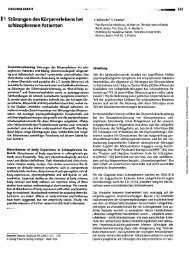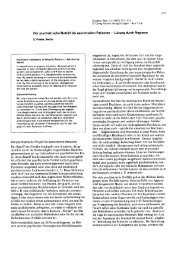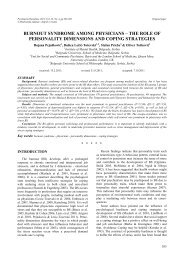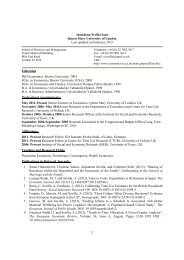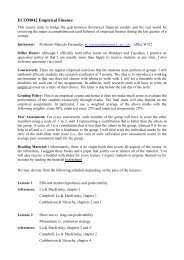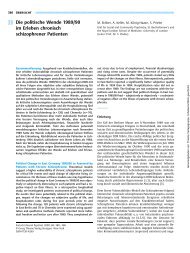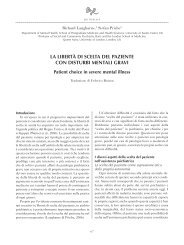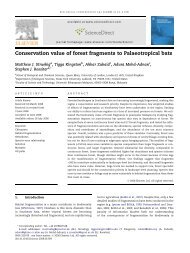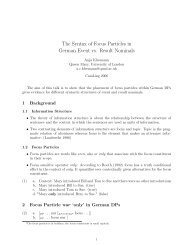Proofs - Personal Webspace for QMUL - Queen Mary, University of ...
Proofs - Personal Webspace for QMUL - Queen Mary, University of ...
Proofs - Personal Webspace for QMUL - Queen Mary, University of ...
You also want an ePaper? Increase the reach of your titles
YUMPU automatically turns print PDFs into web optimized ePapers that Google loves.
clear is the picture regarding depressive disorders. Current<br />
evidence points to an increased [3,7,10,43] as well as decreased<br />
risk [31,59,61,67]. The risk patterns vary according to the examined<br />
ethnic group as well as the country <strong>of</strong> residence [9,12].<br />
It is important to stress at the outset that immigrants are not<br />
one homogeneous population, but constitute a great variety <strong>of</strong><br />
sub- groups, whose social realities will be determined by factors<br />
such as the pre- migration history, levels <strong>of</strong> education, motives<br />
<strong>for</strong> migration, and the extent to which they can acculturate in<br />
the new society. Given the diversity <strong>of</strong> socio- cultural realities<br />
social predictors <strong>of</strong> mental disorders are likely to vary at least<br />
to some extent between regions and cultures [57,61], and may<br />
even differ between subsequent generations <strong>of</strong> immigrants [34].<br />
The process <strong>of</strong> migration itself demands adjustments when<br />
settling in a new societal and cultural environment, which can<br />
create additional stress [64]. Culture and language related barriers<br />
[6,50], as well as societal and structural characteristics <strong>of</strong> the<br />
country <strong>of</strong> settlement such as attitude towards immigrants [8]<br />
or immigration regulations [56], may cause many immigrants<br />
to live in segregated areas with a higher ethnic density and<br />
less favourable social environment. Racism, ethnic discrimination<br />
[49], the process <strong>of</strong> acculturation or acculturative stress [65],<br />
more exposure to stressful life events [48], and lower levels <strong>of</strong><br />
SES [2,40] have been proposed as possible predictors <strong>for</strong> mental<br />
disorders in immigrants.<br />
As mentioned above, no generalizations can be made about<br />
risks <strong>for</strong> mental disorders, in particular affective disorders, in<br />
immigrant groups. To explain this great variability SES factors<br />
have frequently been cited as possible mediators or moderators<br />
<strong>for</strong> increased as well as decreased risk [27]. The erosive effect<br />
<strong>of</strong> low levels <strong>of</strong> SES may particularly impact the association <strong>of</strong><br />
ethnicity and emotional distress [60,62]. Furthermore, it may<br />
be more diffi cult <strong>for</strong> immigrants, especially those with lower<br />
levels <strong>of</strong> education and pr<strong>of</strong>essional training, to receive wellpaid<br />
jobs. Despite high levels <strong>of</strong> education, immigrants may<br />
have diffi culties to get access to jobs in their original fi eld <strong>of</strong><br />
training [20]. Considering the social hardship and inequalities<br />
faced by some immigrant populations [45], a link between risk<br />
<strong>for</strong> mental disorders in immigrants and SES appears plausible.<br />
While some studies suggest that SES does not reliably account<br />
<strong>for</strong> differences in mental health status between immigrants and<br />
native residents [16,30], several other studies do indeed suggest<br />
that differences in mental health between immigrants and<br />
native residents are mainly accounted <strong>for</strong> by SES [29,57,60,62].<br />
It could be hypothesized that not only does the prevalence <strong>of</strong><br />
mental disorders vary according to SES in immigrants, but also<br />
the degree <strong>of</strong> the association between level <strong>of</strong> distress and SES.<br />
Yet, studies examining this relationship in Europe are scarce [47],<br />
and this hypothesis warrants further research.<br />
In Germany the risk <strong>for</strong> socioeconomic hardship strongly varies<br />
by ethnic group and between different regions <strong>of</strong> the country.<br />
While immigrants may be more affl uent in the more prosperous<br />
regions <strong>of</strong> Germany making ends meet may be diffi cult <strong>for</strong> immigrants<br />
in the North- Eastern parts <strong>of</strong> Germany, where overall poverty<br />
and unemployment rates are high [24,25]. Berlin, being the<br />
largest urban centre in Germany, has one <strong>of</strong> the highest poverty<br />
levels (19.0% in 2009) [23] <strong>of</strong> Germany. According to the Berlin<br />
social atlas from 2008 [55], non- German citizens were at higher<br />
risk to live in poverty than German citizens (25.7% vs. 10.6% in<br />
MC. Aichberger et al. / European Psychiatry 27 (2012) / supplement n°2 / S10-S16 S11<br />
German citizens). This pattern is exemplifi ed by the situation <strong>of</strong><br />
Turkish immigrants, who constitute the largest immigrant group<br />
in Berlin, and have continuously faced socioeconomic hardship<br />
and social exclusion [42].<br />
In this study <strong>of</strong> female Turkish immigrants and native German<br />
women living in Berlin, Germany, the following hypotheses were<br />
tested: 1) The level <strong>of</strong> emotional distress is greater in women<br />
with lower levels <strong>of</strong> SES, and 2) the extent <strong>of</strong> the relationship<br />
<strong>of</strong> SES and emotional distress is greater in Turkish immigrant<br />
women than native German women.<br />
2. Subjects and methods<br />
2.1. Sample<br />
The sample derives from a survey that was conducted in<br />
Berlin, Germany from January 2010 to June 2011. The sampling<br />
consisted <strong>of</strong> a random sampling step and snowball sampling.<br />
This approach was chosen since low participation rates were<br />
anticipated <strong>for</strong> female Turkish immigrants. First a random sample<br />
<strong>of</strong> 80,000 women aged 18–75 years residing in Berlin at the time<br />
<strong>of</strong> the study was drawn from the population registry <strong>of</strong> Berlin<br />
in three age strata (18- 34 years, 35- 54 years and 55- 75 years).<br />
Then an algorithm based on name [18,37] was used to identify<br />
female Turkish immigrants and native German women from the<br />
population registry (Meldebehörde). For the native German group,<br />
a random sample <strong>of</strong> N=8,000 was drawn, which was randomly<br />
subdivided into waves. Of these fi nally only N=1,866 were contacted<br />
as part <strong>of</strong> the random sampling step. No further random<br />
sample was drawn from the women <strong>of</strong> Turkish origin, since only<br />
3,884 were identifi ed in the fi rst step. Turkish women were<br />
oversampled since lower participation rates had been anticipated.<br />
Initially only N=136 (7.3%) native German women and N=63<br />
(1.6%) female Turkish immigrants from the random sample who<br />
were contacted agreed to participate in the study. To increase<br />
participation snowball sampling was used in the next step. Here<br />
individuals with specifi c characteristics, e.g. membership to a<br />
specifi c group, are asked to provide contacts <strong>of</strong> other members <strong>of</strong><br />
their group [39]. In this study all women willing to participate in<br />
the study were asked to provide contact details <strong>of</strong> other women<br />
they knew and who were interested in participating in the study.<br />
Via snowballing N=64 native German women and N=142 women<br />
<strong>of</strong> Turkish origin, respectively were recruited. The fi nal sample<br />
comprised N=205 female Turkish immigrants and N=200 native<br />
German women. Recruitment and interviews were stopped at a<br />
predetermined date be<strong>for</strong>e the intervention phase <strong>of</strong> the study<br />
started. Interviews were conducted at respondents’ home and in<br />
some cases at the study centre on campus by female interviewers.<br />
Turkish respondents had the option to choose Turkish or German<br />
as the interview language and were interviewed by bilingual<br />
interviewers. All scales and questionnaires were provided<br />
in Turkish and German. Non- responders with whom contact<br />
was established were asked to complete a short questionnaire.<br />
Additionally, all non- responders were asked to provide reasons<br />
<strong>for</strong> non- participation. A detailed non- responder analysis <strong>of</strong> the<br />
Turkish sample has been published elsewhere [13]. The study<br />
was approved by the Ethics Committee <strong>of</strong> the Charité – <strong>University</strong><br />
Medicine Berlin (EA1/177/08).<br />
<strong>Pro<strong>of</strong>s</strong>




